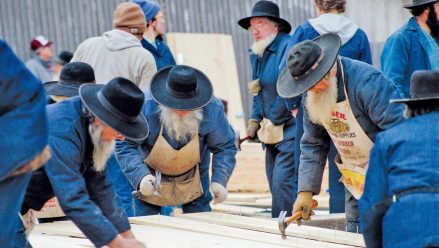What's the difference between Amish and Mennonites

- Amish 101
- Marcus Yoder
- 265526
As with any religious group, there are varying expressions of Anabaptism, of which the Amish and Mennonites are most prominent. To those outside the subculture looking in, this is often confusing. In the greater Holmes County community there are as many as 10 different groups of Amish that have distinct elements that define them within the Amish continuum. It would take much more than one column to define those distinctions and the various interrelated elements of the Amish world. The same is true of Mennonites, who may range from those who still drive horses and carriages to those who are totally assimilated in American culture.
While there are anomalies in any group, there are several features that are common to both groups. First is the idea that at its essence Christianity is about discipleship and a willingness to follow Christ at any cost. Second is the common idea that nonresistance or pacifism is the answer to conflict, and most Amish and Mennonites refuse service in the military. Instead, during times when the draft was in use, they served as conscientious objectors and gave to the world in meaningful ways without the use of force. These two ideas are the common binding factors in Anabaptism regardless of whether one is Amish or Mennonite.
How then can a visitor tell whether the person they meet is Amish or Mennonite? A helpful way to think about this is that all Amish have eschewed the ownership of automobiles as their primary form of locomotion. The Amish have retained the practice of some form of horse-drawn vehicle. This is not meant to be quaint. Rather it is a means to foster a sense of community where one connects to the people and the community within a reasonable radius of travel. While there are a few small groups of Mennonites that do not own automobiles, there are none in the Holmes County community that do not permit ownership of the automobile. There are many Mennonites who wear distinctive garb and beards without mustaches as do the Amish, so in this community, automobile ownership is one of the ways one can define the two groups.
Most Mennonites meet for their church services in meeting houses. The Amish, however, retain the practice of meeting in their homes, shops or barns for their Sunday services. Most Amish still use the German or the common dialect of German, Pennsylvania Dutch, as the primary language of the church services. Most Mennonites use English, and some of their services use modern practices such as worship teams and audiovisual tools in their services.
Each family in an Amish church is expected to take a turn in hosting the service at their home. With this arrangement and their nonuse of automobiles, this limits the size to about 30 households in each “district,” all of which live in near proximity to each other. When a district becomes too large, they will often choose a geographical dividing line such as a creek or road and divide the district, the two becoming two distinct groups that share a common belief but now meet in two places. Most Mennonites do not practice this form of replication and instead focus on missions or outreach, and some grow to large sizes similar to the Protestant model of church growth.
If you wish to learn more about the differences between the Amish and Mennonites, plan a visit to the Amish & Mennonite Heritage Center. The center offers guided tours of “Behalt,” a 10-foot-265-foot cyclorama oil-on-canvas painting that illustrates the heritage of the Amish and Mennonite people from their Anabaptist beginnings in Zurich, Switzerland, to the present day. Behalt means “to keep” or “remember.”
The Amish & Mennonite Heritage Center is open Monday through Saturday from November through March from 9:30 a.m. to 4:30 p.m. and 9 a.m. to 5 p.m. during the summer months. It is located near Berlin in the heart of Ohio’s Amish Country at 5798 County Road 77, Millersburg. Call 330-893-3192 or visit their website at www.behalt.com for more information.
